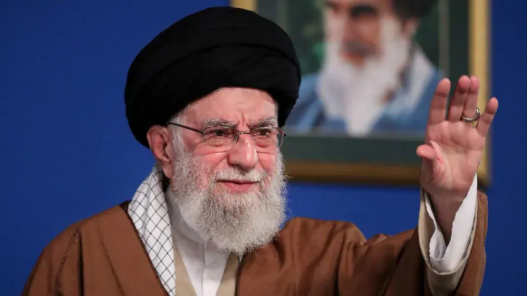

Iran’s Supreme Leader, Ayatollah Ali Khamenei, is once again at the center of global attention amid rising tensions with Israel and the United States. On June 19, Israeli Defence Minister Israel Katz made the most direct threat yet against the 85-year-old cleric, declaring that Khamenei “can no longer be allowed to exist.” A day earlier, Israeli Prime Minister Benjamin Netanyahu told ABC News that targeting Khamenei would “end the conflict, not escalate it.” Former U.S. President Donald Trump echoed similar sentiments on Truth Social, warning, “our patience is growing thin.”
Khamenei, however, has not flinched under pressure. “The Iranian nation cannot be surrendered,” he said recently, warning against the use of threats and boasting about the resilience of the Islamic Republic.
To understand why Khamenei is such a central figure in Middle Eastern geopolitics, it’s crucial to examine his role, his beliefs, and how he has shaped Iran over the last three decades.
In Iran’s theocratic system, the Supreme Leader is the most powerful authority, ranking above the president, judiciary, and parliament. Khamenei holds control over:
The armed forces
The Islamic Revolutionary Guard Corps (IRGC)
Intelligence and security agencies
State media
The judiciary and clerical appointments
He has the authority to declare war or peace, veto laws, dismiss elected officials, and guide foreign policy—especially through the Quds Force, which manages Iran’s regional operations.
Khamenei’s authority is based on velayat-e faqih (guardianship of the Islamic jurist), a Shia Islamic principle that gives religious clerics supreme authority. This doctrine was introduced by his predecessor, Ayatollah Ruhollah Khomeini, and enshrined in Iran’s 1979 constitution.
Born in 1939 in Mashhad, Iran, Khamenei was the second of eight children in a religious, modest family. He began his clerical education in Qom and became a follower of Ayatollah Khomeini in the early 1960s. His opposition to the Shah led to multiple arrests and imprisonment.
After the 1979 Islamic Revolution, Khamenei rose quickly through the ranks. He served as President of Iran from 1981 to 1989 and became Supreme Leader following Khomeini’s death—a role he’s held ever since.
Beyond politics, Khamenei is known for his literary interests. He once described Victor Hugo’s Les Misérables as “the best novel that has been written in history,” encouraging Iranians to read it as a work of profound moral insight.
Khamenei is an ideological hardliner who views liberal democracy and capitalism as morally and spiritually flawed. He has often contrasted Western materialism with the “spiritual superiority” of Islamic civilization. “The West looks at only one dimension — the material,” he once said, while Islamic culture embraces “justice, prayer, independence, and approaching the exalted God.”
His intellectual influences include Islamist theorists like Sayyid Qutb, who argued that Islam without governance is meaningless. He also remains committed to Khomeini’s branding of the United States as the “Great Satan” and Israel as the “Little Satan.”
After a Florida pastor threatened to burn the Quran in 2010, Khamenei claimed it was not an isolated act but part of “Zionist planning centers” and hegemonic designs.
Under Khamenei’s rule, Iran has transformed into a regional power through asymmetric warfare. Instead of direct military engagements, Iran uses proxy groups—like Hezbollah in Lebanon, Hamas in Gaza, the Houthis in Yemen, and Shia militias in Iraq and Syria—to project power and confront enemies including Israel, Saudi Arabia, and the U.S.
Domestically, he’s promoted an economic strategy known as “resistance economy”, aiming to make Iran less dependent on oil exports and more self-reliant amid international sanctions. The strategy encourages trade with Eastern powers like China and Russia and cuts to state subsidies, though the latter has triggered widespread protests.
Khamenei has also championed Iran’s right to pursue nuclear science, calling it a symbol of national pride and independence. While he has insisted that Iran is not pursuing nuclear weapons, he supported the 2015 nuclear deal (JCPOA), only to harshly criticize the U.S. after its unilateral withdrawal under the Trump administration.
As the strategic mastermind of Iran’s regional policy, Khamenei is seen by Israel and the United States as the architect of Tehran’s military support to anti-Israel militant groups and its pursuit of nuclear capabilities. Calls for his removal signal a dangerous escalation in already fraught relations.
For Netanyahu and other Israeli leaders, removing Khamenei is framed as a way to destabilize the command structure of Iran’s military and political system. Trump’s veiled threat about “knowing where Khamenei is hiding” underscores that some U.S. policymakers also view him as the central pillar of Iran’s defiance.
However, Khamenei’s deeply embedded control and the complex structure of Iran’s theocracy make such a move extremely risky, potentially leading to retaliation across the region.
Ayatollah Ali Khamenei has led Iran for more than three decades, during which he has crafted a nation that combines religious ideology, regional ambition, and deep resistance to Western influence. His legacy is one of both survival and confrontation—presiding over a country that has withstood revolutions, wars, and sanctions.
As the world watches the latest tensions unfold, one thing remains clear: Khamenei is not just a religious figure, but a geopolitical force, whose actions—and survival—could determine the direction of the Middle East for years to come.